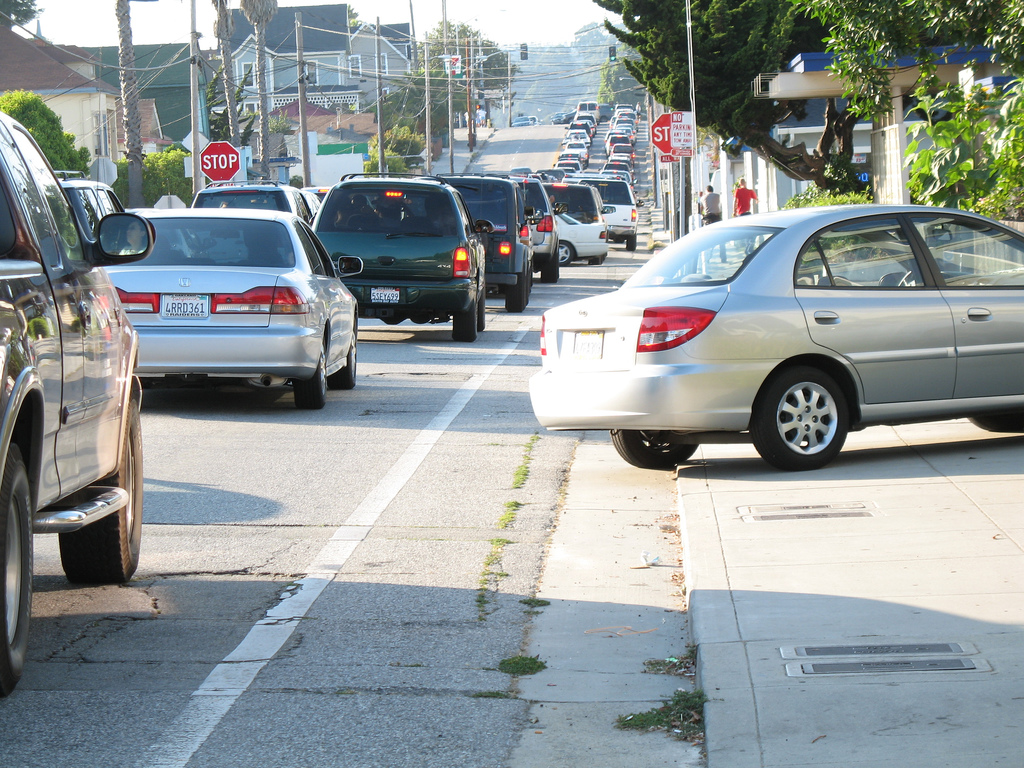What are roads for? For that matter, what’s transportation policy for? Much of the urban reform movement of the last few decades has been about re-asking, and re-answering, these questions. Most people who follow trends in urban policy could outline at least a rough sketch of the debates: high-speed car traffic versus “complete streets” for pedestrians, bicyclists, and transit users; building more and more highway capacity for private vehicles versus investing in “alternative” modes of transportation.
Last week, at his blog, the Quebec-based traffic engineer Simon Vallée posted an excellent diagnosis of the wonkish roots of these disagreements. He frames it as the “engineering” approach against the “economic” approach—and, though he’s an engineer himself, he comes down on the “economic” side.
The basic distinction is this: Engineers typically look at roads as a closed system, with a certain number of vehicles and a given amount of space, and then ask how to arrange that space to ensure the most efficient passage of that quantity of vehicles. The preferences of the people inside the vehicles really don’t enter into the equation. As Vallée puts it, “the engineering approach…essentially eliminates humans from the problem.”

The economic, or behavioral, approach brings back humans—and with them, the idea that given amount of vehicle trips isn’t just a feature of the natural world, but the result of decisions by actual people who want to get somewhere in order to do something. The question then changes in a subtle but profound way: not how to speed vehicles through a road most efficiently, but how to best connect people with the places they want to go.
The engineering approach is simple, but inherently limited: because it takes the number of vehicles as a given, its tools are generally restricted to either creating more space by building new roads and widening existing ones, or getting rid of impediments to the flow of traffic—impediments like safe crossings for pedestrians, or sidewalk or plaza space that could be “better used” as wide-radius side lanes so cars don’t have to slow down as they turn.
In contrast, when vehicle trips aren’t a fact of nature but the result of decisions people make about how to get to the places they want to be—decisions that depend on many different factors, like travel time, cost, and the feasibility of other transportation options—you get a much bigger toolbox. Maybe charging for scarce and valuable road space through congestion pricing could help open up roadways in dense areas so that people who really need to use them can do so without crawling through traffic. Maybe the revenue from those congestion charges could help improve service on public transportation, so that some number of people choose not to drive, reducing the number or shifting the timing of vehicle trips (the same number that the engineering approach treats as unchangeable) and moving people onto much more space-efficient vehicles, like buses. Maybe changing land use policy would allow people to make fewer, shorter vehicle trips, or make other modes, like walking, biking, or transit, more attractive for some of them.

Bringing humans back into the question also allows you to acknowledge that people have desires that aren’t directly related to transportation. Safety, for example. Reducing the number and length of vehicle trips translates straight to fewer car crashes, and fewer avoidable serious injuries and deaths. Making streets a pleasant place to walk and gather—something that’s difficult when sidewalks have been narrowed to make room for speeding cars just feet away—can pay serious economic dividends and help establish a sense of community. In the economic or behavioral approach to transportation policy, all of these goals suddenly become fair game.
We would also add that the engineering approach means that a substantial amount of urban policy energy goes into “getting there”—rather than on the broader experience of “being there,” and how we might maximize those benefits, in terms both economic and social. Turning our cities’ streets into excellent conduits for high-speed vehicles means that they’re not excellent places for people to be. That takes a toll, both on our ability to create tight-knit, supportive communities that people are proud to be a part of, and to create thriving, prosperous neighborhoods with economic opportunities.
Vallée goes into much more detail on his blog, and it’s very much reading his whole post. The takeaway, however, is that transportation isn’t just about infrastructure: it’s about people, and what they want, and the full range of ways that we might help them get it.
